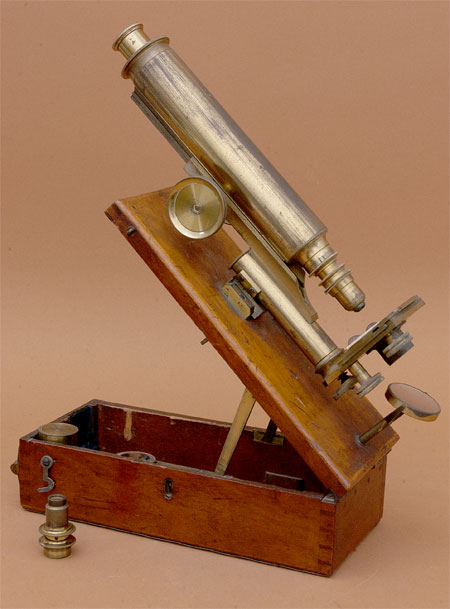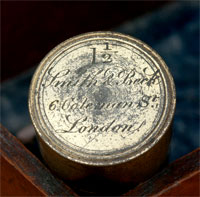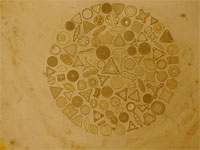 |
|||||
 |
 |
||||
 |
|||||
 |
 |
||||
Smith and Beck Horizontal Compound Microscope (No. 88 ) |
||||||||
 |
Age: c1850 Made by: Smith & Beck Made in: London |
|||||||
 |
||||||||
|
Smith & Beck
6 Coleman St London |
||||||||
 |
||||||||
|
Imaging
|
||||||||
|
This is a microscope made by the firm of Smith and Beck c1850. It is a brass compound microscope mounted horizontally to the top of a fruit wood box. The microscope attaches to the box via a dovetail clasp, with the illuminating mirror pressed into a brass hole. The underside of the top has two tapered brass legs that fit into mounts on either side of the box base. When assembled the microscope is fixed at a comfortable incline. The microscope body has a toothed rack that mates to a matching pinion gear mounted in a cupped and dovetailed sliding mechanism. This rack & pinion assembly acts as the coarse focus mechanism. The stage is mounted to a spring-loaded shaft inserted into the main support cylinder, which itself is mounted to the box. A graduated thumbwheel at the base of the cylinder turns a threaded shaft that allows the spring to move the stage up or down. This assembly forms the fine focus. The stage is rectangular and is geared allowing two thumbwheels to move it in the X or Y direction. The optics of the microscope consist of a Ramsden eyepiece and a multi-lens objective. The high-magnification objective has a correction collar to compensate for the various positions of the draw tube. The microscope can be disassembled and stored in the wooden case. The only accessories are two bone slides, one of which has samples of fish scales. The 1 1/2" objective lens comes with a brass case. The top of the case is engraved "Smith and Beck, 6 Coleman Street London". The microscope body is 24.5cm long. Imaging is very good showing little or no spherical and chromatic aberration. James Smith (d1870) was a "mathematical instrument maker" in London during the first quarter of the 19th Century. Joseph Jackson Lister (1786–1869) employed Smith to make microscopes to accommodate the achromatic objectives he was creating. By 1826 the first instrument based on Lister's design was created by Smith in his company on 50 Ironmonger Row, Old Street, London. One of Smith's early clients was the Royal Microscope Society who, in 1841, recieved its first microscope from Smith. In the early 1840s Richard Beck, nephew of JJ Lister, apprenticed to Smith. In 1847 Beck became a partner of Smith wherein the company changed its name to Smith & Beck and moved to 6 Coleman Street, London. This microscope in the Golub Collection was made by the firm of Smith & Beck c1850. In 1851 Beck's brother Joseph (1829–1891) joined the firm, and in 1857 the company became "Smith, Beck & Beck". In 1865 James Smith retired and the company changed names again to became "R & J Beck". At that time the firm moved to 68 Cornhill, London. From 1870–1885 the R&J Beck company sold microscopes in the United States through the James W Queen & Co. Chestnut Street, Philadelphia. James Smith was elected a member of the RMS in 1840. Richard Beck was elected in 1855 and brother Joseph Beck was elected to the RMS in 1859. Microscope featured 12/2014 |
||||||||